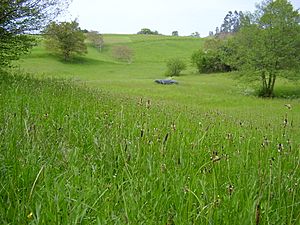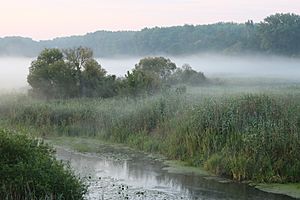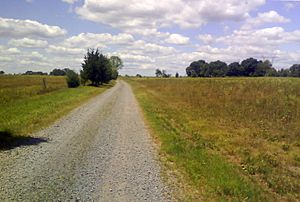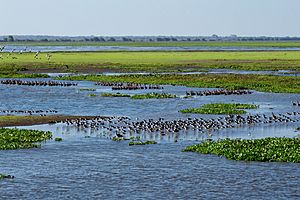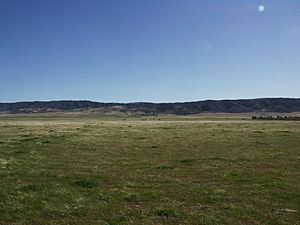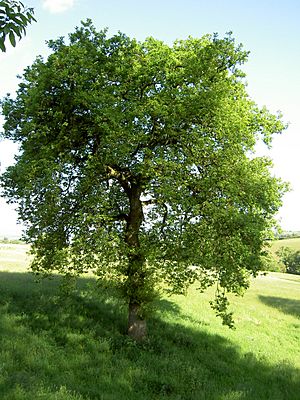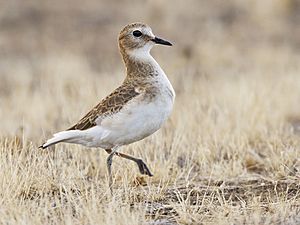Grassland facts for kids
A grassland is a large area of land where the main plants are grasses. You'll find lots of wild grasses here, but not many trees. Grasslands are amazing places found all over the world, including Africa, North America, Central Asia, South America, and parts of Australia. The biggest grasslands are in East Africa.
Some grasslands have a few trees scattered around; these are called savannas. Other types are known as prairies or steppes. Grasslands usually don't get a lot of rain, typically between 25 and 75 centimeters each year. This means they often have hot, sunny summers and cooler winters.
Contents
Exploring Different Grassland Types
Grasslands come in many forms, each with unique features and animals. Here are some of the main types you can find around the globe.
Tropical and Subtropical Grasslands
These grasslands are hot and humid, getting about 90-150 centimeters of rain every year. They are home to tall grasses and scattered trees. You can find many large mammals here, like wildebeest and zebras. A famous example is the Llanos grasslands in South America.
Temperate Grasslands
Temperate grasslands are found in middle latitudes, like the prairies of North America and the Pampas of Argentina. These areas have distinct seasons. Many large plant-eating animals, called herbivores, live here, such as bison, gazelles, and wild horses. You'll also find carnivores like lions, wolves, and cheetahs. Smaller animals like prairie dogs, mice, and snakes also call these grasslands home.
Flooded Grasslands
Some grasslands are covered by water for part of the year or even all year round. The Everglades in Florida and the Pantanal in Brazil are great examples. Animals and plants in these areas are specially adapted to living in wet conditions. The Everglades, for instance, has over 11,000 types of plants, 300 bird species, and 150 fish species!
Mountain Grasslands
These grasslands are found high up in mountain ranges, like the Páramo in the Andes Mountains. The plants and animals living here are tough! They can handle cool, wet weather and strong sunlight.
Tundra Grasslands
In very cold places, like the Arctic tundra, you can find grasses. During past ice ages, a huge grassland called the "mammoth steppe" covered much of the Northern Hemisphere. It was very cold and dry, but it supported many animals. As the Earth warmed, much of this land turned into forests, but some dry parts became the modern Eurasian Steppe.
Desert Grasslands
These are sparse grasslands found in very dry areas, like deserts. The plants and animals here are experts at surviving with very little water and extreme temperatures.
How Grasslands Developed
Grasses are incredibly adaptable plants. They became common towards the end of the Cretaceous period, which was a long time ago when dinosaurs still roamed! Scientists have even found grass fossils in dinosaur droppings.
About 25 million years ago, mountains rose in the western United States. This created a climate that was perfect for grasslands to grow. The first true grasslands appeared about 5 million years ago. Over time, forests shrank, and grasslands spread across the world.
After the last Pleistocene ice ages, grasslands expanded even more in hotter, drier areas and became a dominant feature of the Earth's landscape. Many of the grasslands we see today, especially in Europe, were also shaped by humans. When early farmers cleared forests for agriculture, some areas became meadows and pastures. The grazing of animals and later, mowing by farmers, helped many different plant species to grow together, increasing the variety of life.
Sadly, many of these semi-natural grasslands have been lost over the last century, turned into farms. Today, the remaining ones are often in places not suitable for farming.
Grassland Ecology: Life and Challenges
Grasslands are bursting with life! They are home to an incredible variety of wild plants, including different grasses, sedges, and herbs. Some grasslands in Europe have been found to have over 70 plant species in just one square meter! This amazing plant diversity supports many different insects and birds.
Protecting Grasslands
Unfortunately, many grasslands around the world are in danger. Most have been changed by farming, with fertilizers, weed killers, or plowing destroying the natural plant life. Original grasslands, like the North American prairies, are now very rare.
Almost 90% of Europe's semi-natural grasslands have disappeared in the last century due to farming and other human activities. This is a big problem because many endangered species rely on these special habitats. Conservation groups are working hard to protect the remaining grasslands and encourage landowners to manage them in ways that help wildlife.
Grassland Plants
The plants in a grassland can vary a lot depending on the type of grassland and how much humans have impacted it. In semi-natural grasslands, you might see trees like English oak and silver birch, along with many kinds of herbs.
Grasses and other flowering plants grow best where rainfall is between 500 and 900 millimeters per year. The roots of these plants form strong mats that hold the soil in place, preventing it from washing away.
Grassland Animals
Grasslands support some of the largest groups of animals on Earth. You can find many large grazing animals like zebras, antelopes, American bison, and Przewalski's horse. Where there are many grazers, there are also many predators like lions, cheetahs, and wolves.
Smaller creatures also play a huge role. Mites, insect larvae, nematodes, and earthworms live deep in the soil. These tiny helpers, along with fungi, improve the soil, help roots grow, and make plants stronger against pests.
Threats to Grasslands
Grasslands are very sensitive to changes. Human activities like hunting too many animals or plowing land for farms can cause big problems.
To feed our growing population, many of the world's grasslands, including the American prairies, have been turned into fields for crops like corn and wheat. Even the vast savannas of East Africa are now at risk of being lost to agriculture.
When key species, like buffalo or prairie dogs, are removed, or when new species that don't belong there are introduced, it can upset the natural balance of the ecosystem and harm many other species. Uncontrolled or illegal hunting also threatens many magnificent grassland animals, like elephants and bison, and can lead to species becoming extinct.
Images for kids
-
Setaria pumila, a species of Poaceae (the dominant plant family in grasslands)
-
Coxilhas (hills covered by grasslands) in the Pampas, Rio Grande do Sul state, Brazil.
See also
 In Spanish: Herbazal para niños
In Spanish: Herbazal para niños


